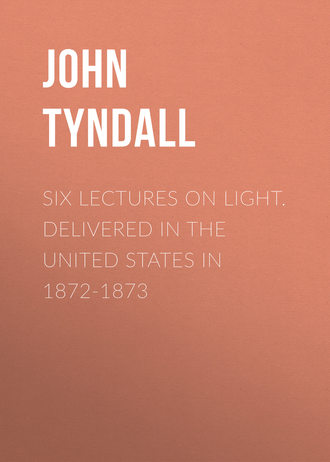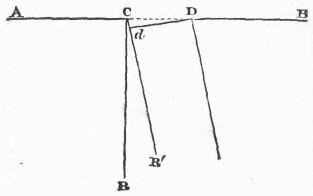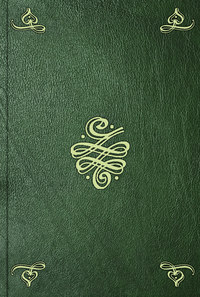 полная версия
полная версияПолная версия
Six Lectures on Light. Delivered In The United States In 1872-1873
'Circular polarization, like circular motion generally, may of course be of two kinds, which differ only in the direction of the motion. And, in fact, to convert the circular polarization produced by this plate from one of these kinds to the other (say from right-handed to left-handed, or vice versâ), we have only to turn the plate round through 90°. Conversely, right-handed circular polarization will be changed by the plate into plane-polarization in one direction, while left-handed will be changed into plane at right angles to the first. Hence if the plate be turned round through 90° we shall see that the bands are shifted in a direction opposite to that in which they were moved at first. In this therefore we have evidence not only that the polarization immediately on either side of a band is circular; but also that that immediately on the one side is right-handed, while that immediately on the other is left-handed28.
'If time permitted, I might enter still further into detail, and show that the polarization between the plane and the circular is elliptical, and even the positions of the longer and shorter axes and the direction of motion in each case. But sufficient has, perhaps, been said for our present purpose.
'Before proceeding to the more varied forms of spectral bands, which I hope presently to bring under your notice, I should like to ask your attention for a few minutes to the peculiar phenomena exhibited when two plates of selenite giving complementary colours are used. The appearance of the spectrum varies with the relative position of the plates. If they are similarly placed—that is, as if they were one plate of crystal—they will behave as a single plate, whose thickness is the sum of the thicknesses of each, and will produce double the number of bands which one alone would give; and when the analyzer is turned, the bands will disappear and re-appear in their complementary positions, as usual in the case of plane-polarization. If one of them be turned round through 45°, a single band will be seen at a particular position in the spectrum. This breaks into two, which recede from one another towards the red and violet ends respectively, or advance towards one another according to the direction in which the analyzer is turned. If the plate be turned through 45° in the opposite direction, the effects will be reversed. The darkness of the bands is, however, not equally complete during their whole passage. Lastly, if one of the plates be turned through 90°, no bands will be seen, and the spectrum will be alternately bright and dark, as if no plates were used, except only that the polarization is itself turned through 90°.
'If a wedge-shaped crystal be used, the bands, instead of being straight, will cross the spectrum diagonally, the direction of the diagonal (dexter or sinister) being determined by the position of the thicker end of the wedge. If two similar wedges be used with their thickest ends together, they will act as a wedge whose angle and whose thickness is double of the first. If they be placed in the reverse position they will act as a flat plate, and the bands will again cross the spectrum in straight lines at right angles to its length.
'If a concave plate be used the bands will dispose themselves in a fanlike arrangement, their divergence depending upon the distance of the slit from the centre of concavity.
'If two quartz wedges, one of which has the optic axis parallel to the edge of the refractory angle, and the other perpendicular to it, but in one of the planes containing the angle (Babinet's Compensator), the appearances of the bands are very various.
'The diagonal bands, besides sometimes doubling themselves as with ordinary wedges, sometimes combine so as to form longitudinal (instead of transverse) bands; and sometimes cross one another so as to form a diaper pattern with bright compartments in a dark framework, and vice versâ, according to the position of the plates.
'The effects of different dispositions of the interposed crystals might be varied indefinitely; but enough has perhaps been said to show the delicacy of the method of spectrum analysis as applied to the examination of polarized light.'
The singular and beautiful effect obtained with a circular plate of selenite, thin at the centre, and gradually thickening towards the circumference, is easily connected with a similar effect obtained with Newton's rings. Let a thin slice of light fall upon the glasses which show the rings, so as to cover a narrow central vertical zone passing through them all. The image of this zone upon the screen is crossed by portions of the iris-rings. Subjecting the reflected beam to prismatic analysis, the resultant spectrum may be regarded as an indefinite number of images of the zone placed side by side. In the image before dispersion we have iris-rings, the extinction of the light being nowhere complete; but when the different colours are separated by dispersion, each colour is crossed transversely by its own system of dark interference bands, which become gradually closer with the increasing refrangibility of the light. The complete spectrum, therefore, appears furrowed by a system of continuous dark bands, crossing the colours transversely, and approaching each other as they pass from red to blue.
In the case of the plate of selenite, a slit is placed in front of the polarizer, and the film of selenite is held close to the slit, so that the light passes through the central zone of the film. As in the case of Newton's rings, the image of the zone is crossed by iris-coloured bands; but when subjected to prismatic dispersion, the light of the zone yields a spectrum furrowed by bands of complete darkness exactly as in the case of Newton's rings and for a similar reason. This is the beautiful effect described by Mr. Spottiswoode as the fanlike arrangement of the bands—the fan opening out at the red end of the spectrum.
MEASUREMENT OF THE WAVES OF LIGHT
The diffraction fringes described in Lecture II., instead of being formed on the retina, may be formed on a screen, or upon ground glass, when they can be looked at through a magnifying lens from behind, or they can be observed in the air when the ground glass is removed. Instead of permitting them to form on the retina, we will suppose them formed on a screen. This places us in a condition to understand, even without trigonometry, the solution of the important problem of measuring the length of a wave of light.

Fig. 57.
We will suppose the screen so distant that the rays falling upon it from the two margins of the slit are sensibly parallel. We have learned in Lecture II. that the first of the dark bands corresponds to a difference of marginal path of one undulation; the second dark band to a difference of path of two undulations; the third dark band to a difference of three undulations, and so on. Now the angular distance of the bands from the centre is capable of exact measurement; this distance depending, as already stated, on the width of the slit. With a slit 1.35 millimeter wide,29 Schwerd found the angular distance of the first dark band from the centre of the field to be 1'38"; the angular distances of the second, third, fourth dark bands being twice, three times, four times this quantity.
Let A B, fig. 57, be the plate in which the slit is cut, and C D the grossly exaggerated width of the slit, with the beam of red light proceeding from it at the obliquity corresponding to the first dark band. Let fall a perpendicular from one edge, D, of the slit on the marginal ray of the other edge at d. The distance, C d, between the foot of this perpendicular and the other edge is the length of a wave of the light. The angle C D d, moreover, being equal to R C R', is, in the case now under consideration, 1'38". From the centre D, with the width D C as radius, describe a semicircle; its radius D C being 1.35 millimeter, the length of this semicircle is found by an easy calculation to be 4.248 millimeters. The length C d is so small that it sensibly coincides with the arc of the circle. Hence the length of the semicircle is to the length C d of the wave as 180° to 1'38", or, reducing all to seconds, as 648,000" to 98". Thus, we have the proportion—
648,000 : 98 :: 4.248 to the wave-length C d.
Making the calculation, we find the wave-length for this particular kind of light to be 0.000643 of a millimeter, or 0.000026 of an inch.
1
Among whom may be especially mentioned the late Sir Edmund Head, Bart., with whom I had many conversations on this subject.
2
At whose hands it gives me pleasure to state I have always experienced honourable and liberal treatment.
3
One of the earliest of these came from Mr. John Amory Lowell of Boston.
4
It will be subsequently shown how this simple apparatus may be employed to determine the 'polarizing angle' of a liquid.
5
From this principle Sir John Herschel deduces in a simple and elegant manner the fundamental law of reflection.—See Familiar Lectures, p. 236.
6
The low dispersive power of water masks, as Helmholtz has remarked, the imperfect achromatism of the eye. With the naked eye I can see a distant blue disk sharply defined, but not a red one. I can also see the lines which mark the upper and lower boundaries of a horizontally refracted spectrum sharp at the blue end, but ill-defined at the red end. Projecting a luminous disk upon a screen, and covering one semicircle of the aperture with a red and the other with a blue or green glass, the difference between the apparent sizes of the two semicircles is in my case, and in numerous other cases, extraordinary. Many persons, however, see the apparent sizes of the two semicircles reversed. If with a spectacle glass I correct the dispersion of the red light over the retina, then the blue ceases to give a sharply defined image. Thus examined, the departure of the eye from achromatism appears very gross indeed.
7
Both in foliage and in flowers there are striking differences of absorption. The copper beech and the green beech, for example, take in different rays. But the very growth of the tree is due to some of the rays thus taken in. Are the chemical rays, then, the same in the copper and the green beech? In two such flowers as the primrose and the violet, where the absorptions, to judge by the colours, are almost complementary, are the chemically active rays the same? The general relation of colour to chemical action is worthy of the application of the method by which Dr. Draper proved so conclusively the chemical potency of the yellow rays of the sun.
8
Young, Helmholtz, and Maxwell reduce all differences of hue to combinations in different proportions of three primary colours. It is demonstrable by experiment that from the red, green, and violet all the other colours of the spectrum may be obtained.
Some years ago Sir Charles Wheatstone drew my attention to a work by Christian Ernst Wünsch, Leipzig 1792, in which the author announces the proposition that there are neither five nor seven, but only three simple colours in white light. Wünsch produced five spectra, with five prisms and five small apertures, and he mixed the colours first in pairs, and afterwards in other ways and proportions. His result is that red is a simple colour incapable of being decomposed; that orange is compounded of intense red and weak green; that yellow is a mixture of intense red and intense green; that green is a simple colour; that blue is compounded of saturated green and saturated violet; that indigo is a mixture of saturated violet and weak green; while violet is a pure simple colour. He also finds that yellow and indigo blue produce white by their mixture. Yellow mixed with bright blue (Hochblau) also produces white, which seems, however, to have a tinge of green, while the pigments of these two colours when mixed always give a more or less beautiful green, Wünsch very emphatically distinguishes the mixture of pigments from that of lights. Speaking of the generation of yellow, he says, 'I say expressly red and green light, because I am speaking about light-colours (Lichtfarben), and not about pigments.' However faulty his theories may be, Wünsch's experiments appear in the main to be precise and conclusive. Nearly ten years subsequently, Young adopted red, green, and violet as the three primary colours, each of them capable of producing three sensations, one of which, however, predominates over the two others. Helmholtz adopts, elucidates, and enriches this notion. (Popular Lectures, p. 249. The paper of Helmholtz on the mixture of colours, translated by myself, is published in the Philosophical Magazine for 1852. Maxwell's memoir on the Theory of Compound Colours is published in the Philosophical Transactions, vol. 150, p. 67.)
9
The following charming extract, bearing upon this point, was discovered and written out for me by my deeply lamented friend Dr. Bence Jones, when Hon. Secretary to the Royal Institution:—
'In every kind of magnitude there is a degree or sort to which our sense is proportioned, the perception and knowledge of which is of the greatest use to mankind. The same is the groundwork of philosophy; for, though all sorts and degrees are equally the object of philosophical speculation, yet it is from those which are proportioned to sense that a philosopher must set out in his inquiries, ascending or descending afterwards as his pursuits may require. He does well indeed to take his views from many points of sight, and supply the defects of sense by a well-regulated imagination; nor is he to be confined by any limit in space or time; but, as his knowledge of Nature is founded on the observation of sensible things, he must begin with these, and must often return to them to examine his progress by them. Here is his secure hold: and as he sets out from thence, so if he likewise trace not often his steps backwards with caution, he will be in hazard of losing his way in the labyrinths of Nature.'—(Maclaurin: An Account of Sir I. Newton's Philosophical Discoveries. Written 1728; second edition, 1750; pp. 18, 19.)
10
I do not wish to encumber the conception here with the details of the motion, but I may draw attention to the beautiful model of Prof. Lyman, wherein waves are shown to be produced by the circular motion of the particles. This, as proved by the brothers Weber, is the real motion in the case of water-waves.
11
Copied from Weber's Wellenlehre.
12
See Lectures on Sound, 1st and 2nd ed., Lecture VII.; and 3rd ed., Chap. VIII. Longmans.
13
Boyle's Works, Birch's edition, p. 675.
14
Page 743.
15
The beautiful plumes produced by water-crystallization have been successfully photographed by Professor Lockett.
16
In a little volume entitled 'Forms of Water,' I have mentioned that cold iron floats upon molten iron. In company with my friend Sir William Armstrong, I had repeated opportunities of witnessing this fact in his works at Elswick, 1863. Faraday, I remember, spoke to me subsequently of the perfection of iron castings as probably due to the swelling of the metal on solidification. Beyond this, I have given the subject no special attention; and I know that many intelligent iron-founders doubt the fact of expansion. It is quite possible that the solid floats because it is not wetted by the molten iron, its volume being virtually augmented by capillary repulsion. Certain flies walk freely upon water in virtue of an action of this kind. With bismuth, however, it is easy to burst iron bottles by the force of solidification.
17
This beautiful law is usually thus expressed: The index of refraction of any substance is the tangent of its polarizing angle. With the aid of this law and an apparatus similar to that figured at page 15, we can readily determine the index of refraction of any liquid. The refracted and reflected beams being visible, they can readily be caused to inclose a right angle. The polarizing angle of the liquid may be thus found with the sharpest precision. It is then only necessary to seek out its natural tangent to obtain the index of refraction.
18
Whewell.
19
Removed from us since these words were written.
20
The only essay known to me on the Undulatory Theory, from the pen of an American writer, is an excellent one by President Barnard, published in the Smithsonian Report for 1862.
21
Boyle's Works, Birch's edition, vol. i. pp, 729 and 730.
22
Werke, B. xxix. p. 24.
23
Defined in Lecture I.
24
This circumstance ought not to be lost sight of in the examination of compound spectra. Other similar instances might be cited.
25
The dark band produced when the sodium is placed within the lamp was observed on the same occasion. Then was also observed for the first time the magnificent blue band of lithium which the Bunsen's flame fails to bring out.
26
New York: for more than a decade no such weather had been experienced. The snow was so deep that the ordinary means of locomotion were for a time suspended.
27
'Il faut reconnaître que parmi les peuples civilisés de nos jours il en est pen chez qui les hautes sciences aient fait moins de progrès qu'aux États-Unis, ou qui aient fourni moins de grands artistes, de poëtes illustres et de célèbres écrivains.' (De la Démocratie en Amérique, etc. tome ii. p. 36.)
28
At these points the two rectangular vibrations into which the original polarized ray is resolved by the plates of gypsum, act upon each other like the two rectangular impulses imparted to our pendulum in Lecture IV., one being given when the pendulum is at the limit of its swing. Vibration is thus converted into rotation.
29
The millimeter is about 1/25th of an inch.





